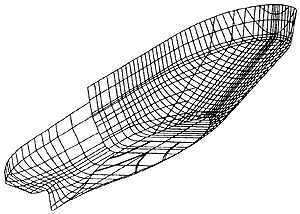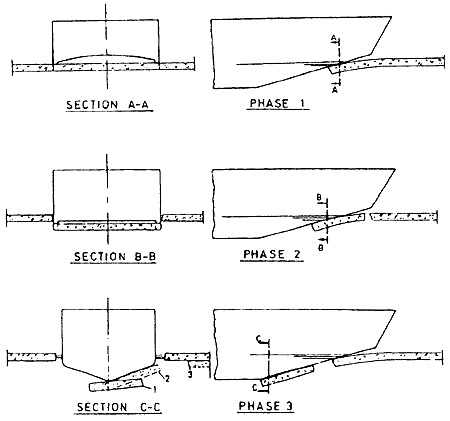The bow form shown here is called a spoon bow because its convex form bears a striking resemblance to a spoon (Figure 4.1-12). The bow lines of the spoon bow contact ice at a much lower angle than the wedge-type, and the spoon bow can break ice fully by bending. Other round bow forms are sometimes called the cylindrical bow and the conical bow; in practice there is no clear distinction between these types.

Figure 4.1-12 Spoon bow (Kapitan Nikolaev)
The spoon bow follows conventional working theories, reducing ice resistance predominantly by bending the ice to fracture it. Another design that uses a radically different mechanism is the WAAS bow (Freitas, 1978). In this design, the two sides at the bottom of the forward part hang lower than the center, forming sharp edges. These edges place a vertical downward force to shear the ice (Figure 4.1-13). Due to forward motion of the ship, the ship bottom successively pushes down the ice sheared off by the ship's edges and breaks it by bending. The broken ice pieces are finally pushed aside below the ice at both sides of the ship. The WAAS bow was conceived out of the observation that the shearing strength of ice is usually lower than the flexural strength, but other benefits have been obtained as well. The edges of the channel formed in the wake of the icebreaker are neat and cleanly defined. Moreover, the broken ice fragments are pushed aside below the ice at both sides of the ship, so the channel is kept largely clear of these fragments (Figure 4.1-14). This improvement is an important factor for the safety of the following ship during ice escort.

Figure 4.1-13 Ice fracture mechanism of the WAAS bow (from Freitas, 1978)
In some recently developed icebreaking hull forms, together with the spoon or WAAS bow, a reamer hull form has been designed. In this design concept the parallel and aft parts of the hull are made narrower than the forebody and a reamer is fitted between them. One of the purposes of the reamer is to reduce the resistance of the parallel body. In normal hull designs, resistance is generated by friction between channel edges and the hull surface of the parallel body and also by complex interactions between the hull surface, channel edges and broken ice pieces entrapped in the gap. The reamer model is expected to reduce this component of resistance by making the gap formed by the bow wider with respect to the parallel section. The second objective of the reamer is to improve the ship's turning ability. Except in specially built vessels, polar ships have no icebreaking capability in the stern and are unable to perform icebreaking while turning. The ship's turning ability is then decided by the relative turning angle of the ship in the formed channel and the left-right difference in icebreaking features around the bow.
BACK CONTENTS NEXT